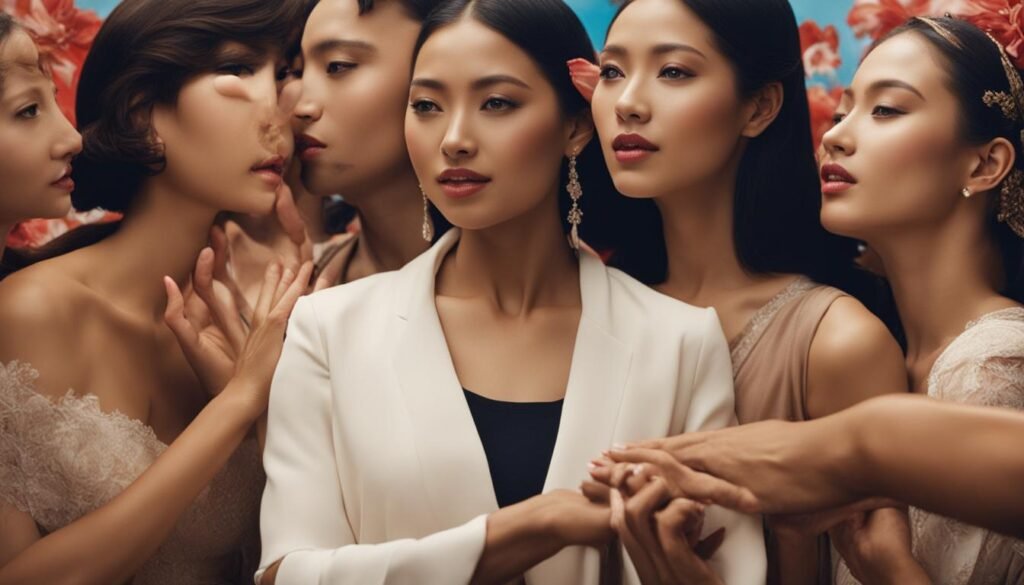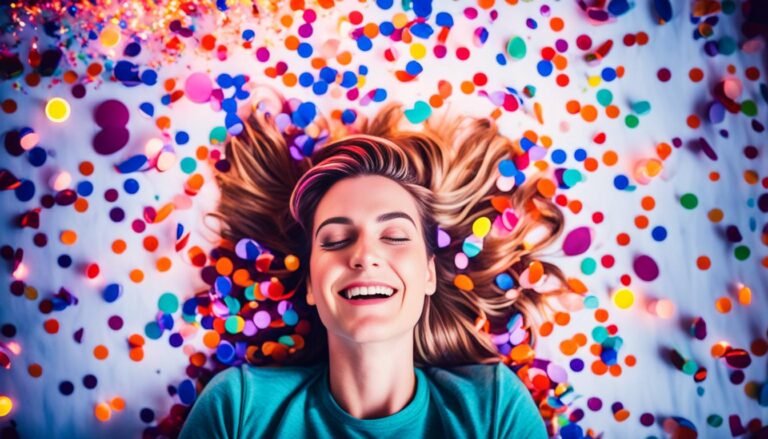Why is white skin so beautiful?
Beauty standards and perceptions vary across cultures, shaping our ideals of what is considered attractive. In Japan, for instance, white skin has been associated with beauty since ancient times. But why? What cultural influences have led to the perception that white skin is the epitome of beauty?
Join us as we delve into the fascinating history and cultural context surrounding the preference for white skin in Japan and explore how societal ideals have shaped perceptions of beauty. Discover the influence of Western beauty norms, the impact of the cosmetics industry, and the growing movement towards embracing diversity and inclusivity.
Are our beauty standards merely a product of culture and media influence, or is there a deeper psychological reason behind our attraction to white skin? Let’s uncover the answers together.
- White skin has been associated with beauty in Japan for centuries.
- Historical context and societal ideals have contributed to the preference for white skin.
- Western influence and the cosmetics industry have further reinforced the belief in white skin as the beauty ideal.
- There is a growing movement towards promoting diversity and inclusivity in the beauty industry.
- Our attraction to white skin may be influenced by both cultural and psychological factors.
The Evolution of Beauty Ideals Across Time and Culture
Beauty ideals have evolved throughout history and across different cultures, reflecting the diverse perspectives and cultural norms that shape our perceptions of beauty. From the pale white skin of the European Middle Ages to the tanned skin of the 1960s, beauty standards have continuously transformed, influenced by societal trends and global diversity.
During the European Middle Ages, pale white skin was considered the epitome of beauty. This preference for fair skin was rooted in cultural norms and societal ideals, where lighter skin was associated with nobility and aristocracy. Women would go to great lengths to achieve a pale complexion, using powders and cosmetics that contained lead and other harmful substances.
In the Renaissance period, curvy women with lightly rose-colored cheeks and dark-brown eyes were considered beautiful. The ideal beauty was associated with vitality and fertility, emphasizing the natural beauty of the human form.
The trend shifted to a preference for tanned skin in Europe during the 1960s, following the rise of leisure activities like vacationing and sunbathing. A sun-kissed glow became synonymous with health and an active lifestyle.
However, in recent years, there has been a counter-trend of embracing the Snow White beauty ideal, characterized by fair skin, rosy cheeks, and dark hair. This shift can be seen as a response to the awareness and appreciation of global diversity, challenging the narrow definition of beauty.
“Beauty standards are not universal. They vary across time and culture, reflecting the values and ideals of different societies.” – Dr. Emily Brown, Cultural Anthropologist
In Japan, beauty ideals have long been influenced by cultural norms and historical perspectives. Besides the preference for white skin, there is also a subculture called Ganguro that embraces a dark tan and vibrant makeup, challenging traditional beauty norms.
Similarly, in India, perceptions of beauty have been shaped by societal biases and racial hierarchies. Skin whitening has been a popular trend, perpetuated by media and advertising, but there has been a shift towards celebrating natural skin tones and challenging these narrow beauty ideals.
Anthropological studies suggest that beauty standards and preferences for skin tone vary across genders and ethnic groups, highlighting the importance of inclusivity and embracing diverse beauty ideals.
| Time Period | Beauty Ideal | Example |
|---|---|---|
| European Middle Ages | Pale white skin | Queen Elizabeth I |
| Renaissance | Curvy women with rose-colored cheeks | Mona Lisa |
| 1960s | Tanned skin | Brigitte Bardot |
| 2010s | Snow White beauty ideal | Emma Watson |
The market for tanning lotions and whitening creams reflects the demand for altering skin tone to fit these ever-changing beauty standards. However, it is crucial to recognize the importance of embracing diversity and challenging the notion that there is a singular definition of beauty.
The Impact of Beauty Ideals on Self-Perception
The constant evolution of beauty ideals can have a significant impact on individuals’ self-perception and self-esteem. The unrealistic beauty standards perpetuated by media and advertising can create unrealistic expectations and a constant desire to conform to these norms.
It is important to celebrate and appreciate the natural diversity of beauty, encouraging individuals to embrace their unique features and recognize that beauty comes in various forms. By challenging societal norms and promoting inclusivity, we can create a more accepting and diverse beauty culture.
The Impact of White Skin Obsession in Asia
The obsession with white skin is particularly prevalent in Asia. This beauty standard has significant implications in societies like Thailand, where dark-skinned women have been underrepresented. The cultural norm associates dark skin with working in the fields, while pale skin is seen as a symbol of a higher social class.
Beauty pageants further reinforce the belief that lighter skin is more attractive. These competitions act as a platform where the beauty ideal of white skin is celebrated and upheld. Media plays a crucial role in perpetuating this preference, with television, magazines, and billboards showcasing images that promote and idolize white skin as the epitome of beauty.
The pressure to conform to this beauty standard affects both women and men, leading to a widespread demand for products and services that cater to the desire for white skin. Cosmetic companies capitalize on this obsession, offering whitening creams, lotions, and treatments which claim to lighten the skin tone.
However, not all advertising campaigns promoting the ideal of white skin are met with support. There have been instances where such campaigns faced backlash for perpetuating unrealistic beauty standards. Nonetheless, the trend continues, fueled by Korean beauty standards that have gained popularity across Asia, thanks to the influence of entertainment and media.
The impact of white skin obsession in Asia is further reflected in the rising demand for whitening products. This growing market indicates the significant interest in achieving a lighter complexion, driven by cultural norms and media influence.

The Effect of Beauty Pageants
Beauty pageants play a significant role in reinforcing the belief that white skin is the epitome of beauty. These competitions showcase contestants who fit the traditional beauty standards, perpetuating the idea that lighter skin is more attractive and desirable. The emphasis on white skin in beauty pageants further contributes to the obsession with achieving a lighter complexion.
“Beauty pageants highlight and reinforce the belief that lighter skin is more attractive.”
The Influence of Media
Media, including television, magazines, and billboards, perpetuates the beauty ideal of white skin. Images and advertisements often portray individuals with fair skin as the embodiment of beauty and success. This constant exposure to such media representation influences societal perceptions, leading to the internalization of white skin as the standard of beauty.
“Media plays a crucial role in perpetuating the preference for white skin.”
The Pressure to Conform
The societal pressure to conform to the beauty standard of white skin affects both women and men. In Asian cultures, achieving a lighter complexion is often associated with success, attractiveness, and social acceptance. This pressure drives individuals to invest in a wide range of products and services that promise to lighten their skin tone.
“The pressure to have white skin affects both women and men.”
In conclusion, the obsession with white skin in Asia is deeply rooted in cultural norms and perpetuated by beauty pageants and media influence. The demand for whitening products reflects the market’s interest in achieving a lighter complexion, highlighting the significant impact of white skin obsession in the region.
Conclusion
In conclusion, the preference for white skin as a beauty ideal is deeply ingrained in various cultures, including Japan and many parts of Asia. Historical influences, societal norms, and media portrayal have all played a significant role in perpetuating this obsession. However, there is a growing movement towards embracing diversity and inclusivity in the beauty industry, challenging the narrow definition of beauty.
It is essential to recognize that beauty ideals have evolved throughout history and vary across different cultures. The focus on white skin as the epitome of beauty is not universal but rather influenced by historical, cultural, and societal factors. The marketing of whitening products has driven the demand for altering skin tone, but there is increasing awareness of the harmful impact of these products and the need for more inclusive beauty standards.
We must strive for a society where beauty is celebrated in all its forms and where people of diverse skin tones are represented and valued. It is important to challenge the narrow perception of beauty based on skin color and embrace the uniqueness of individuals. By promoting inclusivity, we can create a more accepting and empowering environment for everyone.






